KNOWLEDGE EXCHANGE PROJECT: Aldi's Business Expansion in India
VerifiedAdded on 2022/12/27
|24
|7190
|30
Project
AI Summary
This project, titled "KNOWLEDGE EXCHANGE PROJECT: Aldi's Business Expansion in India," conducts a comprehensive analysis of Aldi's planned expansion into the Indian market. It begins with an introduction to Aldi's global presence and the rationale behind targeting the Indian market, highlighting the country's growth potential. The project then delves into a literature review, examining current market trends in India, project management methodologies for business expansion, and the associated risks and benefits. A cost-benefit analysis is presented, demonstrating the potential financial gains from the investment. The project objectives include identifying market trends, understanding project management stages, analyzing risks and benefits, and identifying strategies to mitigate risks. The methodology outlines project planning, resourcing, and findings, supported by evidence of activity, objectives achieved, impact on business, and a sustainability plan. The project concludes with reflections and recommendations for Aldi's successful entry into the Indian market, emphasizing the dynamic nature of the market and the importance of strategic planning to overcome challenges and capitalize on opportunities, all aimed at increasing market share.
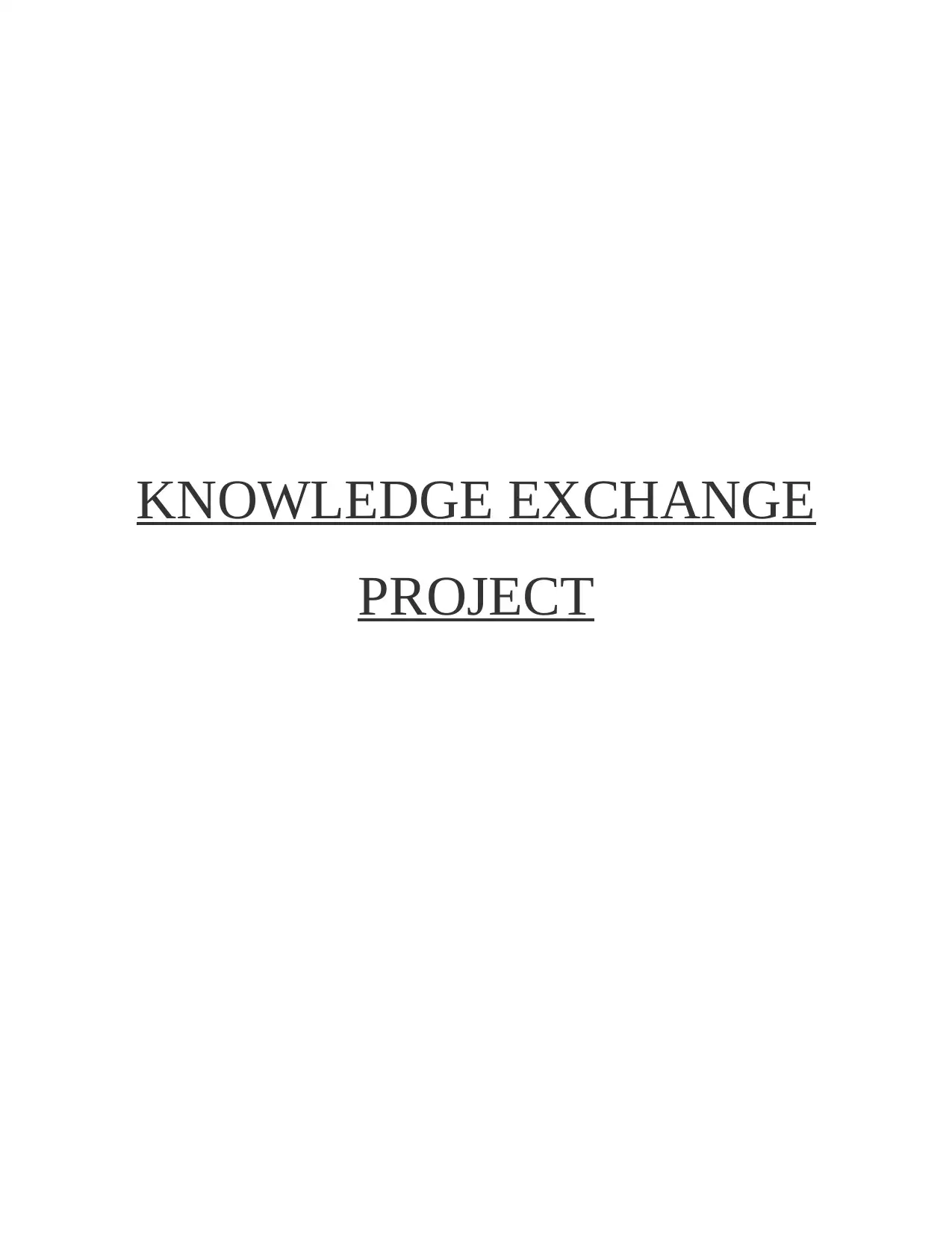
KNOWLEDGE EXCHANGE
PROJECT
PROJECT
Paraphrase This Document
Need a fresh take? Get an instant paraphrase of this document with our AI Paraphraser
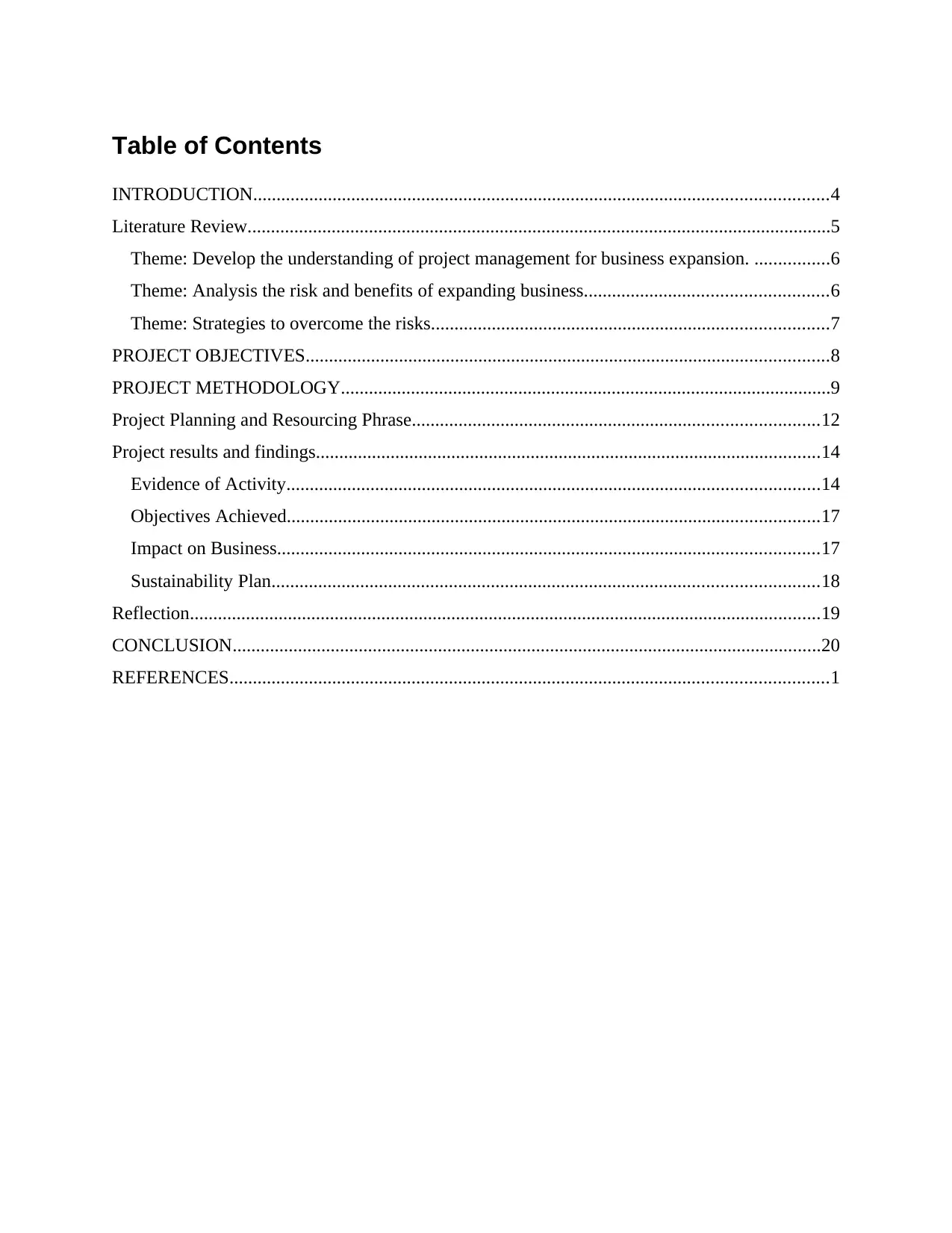
Table of Contents
INTRODUCTION...........................................................................................................................4
Literature Review.............................................................................................................................5
Theme: Develop the understanding of project management for business expansion. ................6
Theme: Analysis the risk and benefits of expanding business....................................................6
Theme: Strategies to overcome the risks.....................................................................................7
PROJECT OBJECTIVES................................................................................................................8
PROJECT METHODOLOGY.........................................................................................................9
Project Planning and Resourcing Phrase.......................................................................................12
Project results and findings............................................................................................................14
Evidence of Activity..................................................................................................................14
Objectives Achieved..................................................................................................................17
Impact on Business....................................................................................................................17
Sustainability Plan.....................................................................................................................18
Reflection.......................................................................................................................................19
CONCLUSION..............................................................................................................................20
REFERENCES................................................................................................................................1
INTRODUCTION...........................................................................................................................4
Literature Review.............................................................................................................................5
Theme: Develop the understanding of project management for business expansion. ................6
Theme: Analysis the risk and benefits of expanding business....................................................6
Theme: Strategies to overcome the risks.....................................................................................7
PROJECT OBJECTIVES................................................................................................................8
PROJECT METHODOLOGY.........................................................................................................9
Project Planning and Resourcing Phrase.......................................................................................12
Project results and findings............................................................................................................14
Evidence of Activity..................................................................................................................14
Objectives Achieved..................................................................................................................17
Impact on Business....................................................................................................................17
Sustainability Plan.....................................................................................................................18
Reflection.......................................................................................................................................19
CONCLUSION..............................................................................................................................20
REFERENCES................................................................................................................................1

⊘ This is a preview!⊘
Do you want full access?
Subscribe today to unlock all pages.

Trusted by 1+ million students worldwide
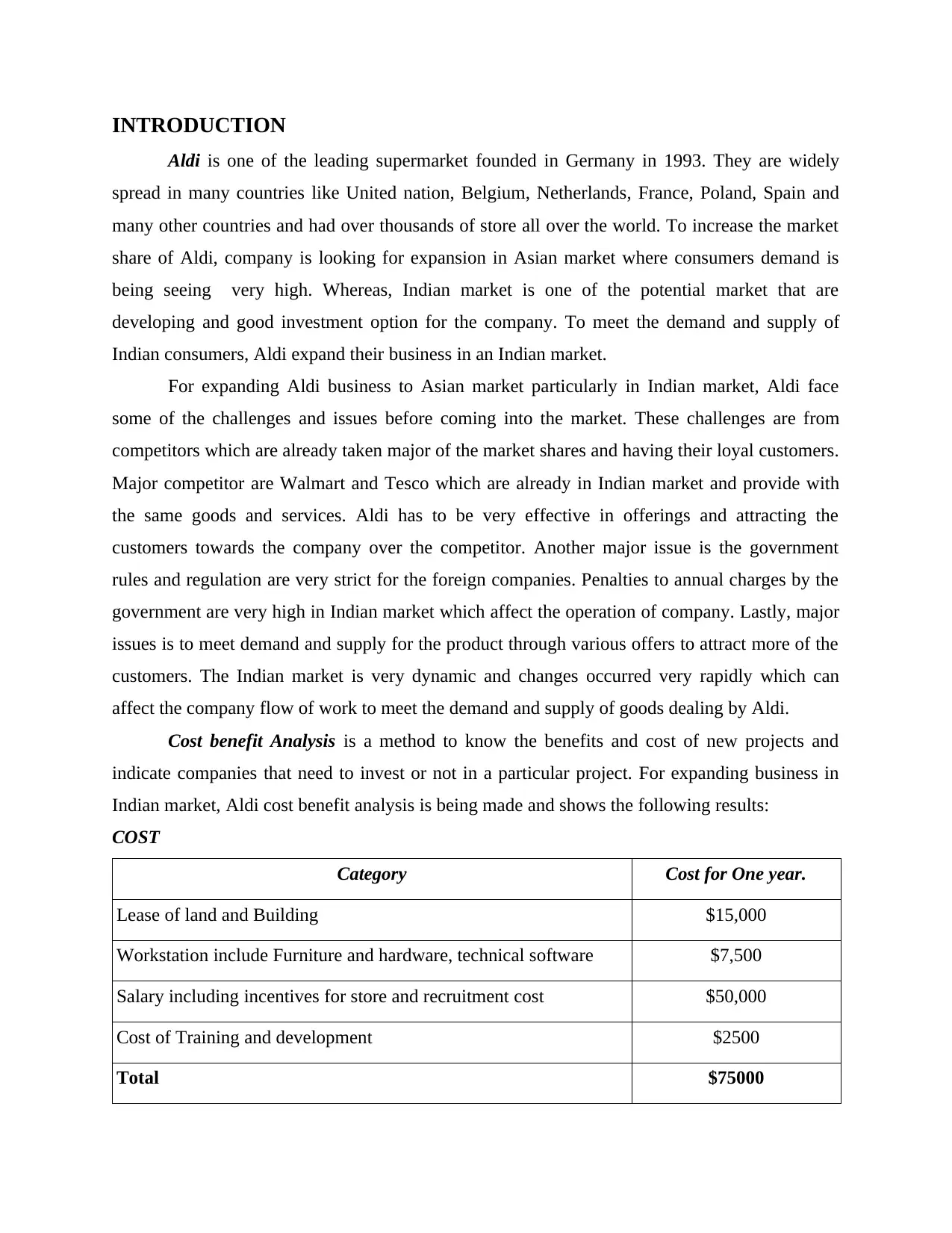
INTRODUCTION
Aldi is one of the leading supermarket founded in Germany in 1993. They are widely
spread in many countries like United nation, Belgium, Netherlands, France, Poland, Spain and
many other countries and had over thousands of store all over the world. To increase the market
share of Aldi, company is looking for expansion in Asian market where consumers demand is
being seeing very high. Whereas, Indian market is one of the potential market that are
developing and good investment option for the company. To meet the demand and supply of
Indian consumers, Aldi expand their business in an Indian market.
For expanding Aldi business to Asian market particularly in Indian market, Aldi face
some of the challenges and issues before coming into the market. These challenges are from
competitors which are already taken major of the market shares and having their loyal customers.
Major competitor are Walmart and Tesco which are already in Indian market and provide with
the same goods and services. Aldi has to be very effective in offerings and attracting the
customers towards the company over the competitor. Another major issue is the government
rules and regulation are very strict for the foreign companies. Penalties to annual charges by the
government are very high in Indian market which affect the operation of company. Lastly, major
issues is to meet demand and supply for the product through various offers to attract more of the
customers. The Indian market is very dynamic and changes occurred very rapidly which can
affect the company flow of work to meet the demand and supply of goods dealing by Aldi.
Cost benefit Analysis is a method to know the benefits and cost of new projects and
indicate companies that need to invest or not in a particular project. For expanding business in
Indian market, Aldi cost benefit analysis is being made and shows the following results:
COST
Category Cost for One year.
Lease of land and Building $15,000
Workstation include Furniture and hardware, technical software $7,500
Salary including incentives for store and recruitment cost $50,000
Cost of Training and development $2500
Total $75000
Aldi is one of the leading supermarket founded in Germany in 1993. They are widely
spread in many countries like United nation, Belgium, Netherlands, France, Poland, Spain and
many other countries and had over thousands of store all over the world. To increase the market
share of Aldi, company is looking for expansion in Asian market where consumers demand is
being seeing very high. Whereas, Indian market is one of the potential market that are
developing and good investment option for the company. To meet the demand and supply of
Indian consumers, Aldi expand their business in an Indian market.
For expanding Aldi business to Asian market particularly in Indian market, Aldi face
some of the challenges and issues before coming into the market. These challenges are from
competitors which are already taken major of the market shares and having their loyal customers.
Major competitor are Walmart and Tesco which are already in Indian market and provide with
the same goods and services. Aldi has to be very effective in offerings and attracting the
customers towards the company over the competitor. Another major issue is the government
rules and regulation are very strict for the foreign companies. Penalties to annual charges by the
government are very high in Indian market which affect the operation of company. Lastly, major
issues is to meet demand and supply for the product through various offers to attract more of the
customers. The Indian market is very dynamic and changes occurred very rapidly which can
affect the company flow of work to meet the demand and supply of goods dealing by Aldi.
Cost benefit Analysis is a method to know the benefits and cost of new projects and
indicate companies that need to invest or not in a particular project. For expanding business in
Indian market, Aldi cost benefit analysis is being made and shows the following results:
COST
Category Cost for One year.
Lease of land and Building $15,000
Workstation include Furniture and hardware, technical software $7,500
Salary including incentives for store and recruitment cost $50,000
Cost of Training and development $2500
Total $75000
Paraphrase This Document
Need a fresh take? Get an instant paraphrase of this document with our AI Paraphraser
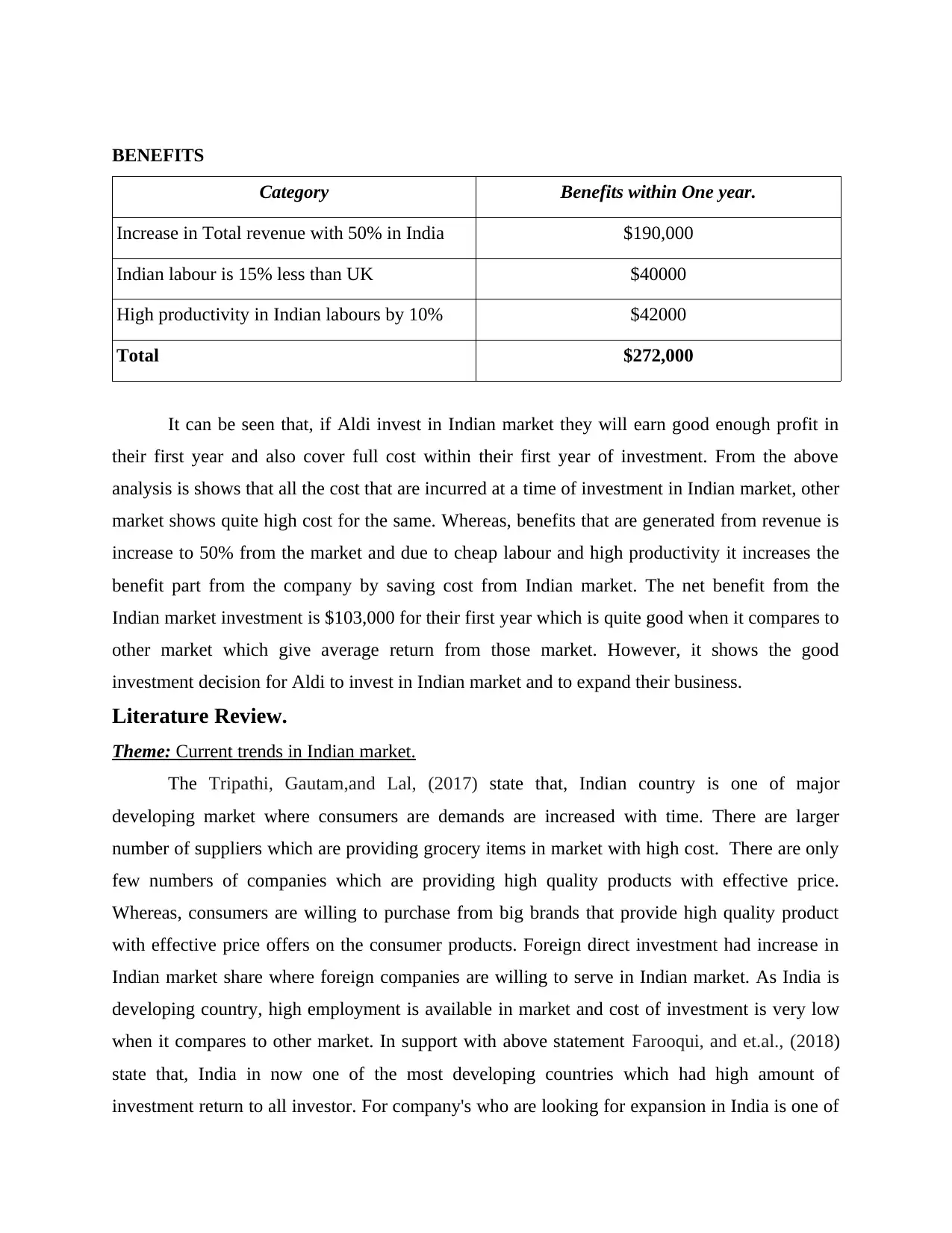
BENEFITS
Category Benefits within One year.
Increase in Total revenue with 50% in India $190,000
Indian labour is 15% less than UK $40000
High productivity in Indian labours by 10% $42000
Total $272,000
It can be seen that, if Aldi invest in Indian market they will earn good enough profit in
their first year and also cover full cost within their first year of investment. From the above
analysis is shows that all the cost that are incurred at a time of investment in Indian market, other
market shows quite high cost for the same. Whereas, benefits that are generated from revenue is
increase to 50% from the market and due to cheap labour and high productivity it increases the
benefit part from the company by saving cost from Indian market. The net benefit from the
Indian market investment is $103,000 for their first year which is quite good when it compares to
other market which give average return from those market. However, it shows the good
investment decision for Aldi to invest in Indian market and to expand their business.
Literature Review.
Theme: Current trends in Indian market.
The Tripathi, Gautam,and Lal, (2017) state that, Indian country is one of major
developing market where consumers are demands are increased with time. There are larger
number of suppliers which are providing grocery items in market with high cost. There are only
few numbers of companies which are providing high quality products with effective price.
Whereas, consumers are willing to purchase from big brands that provide high quality product
with effective price offers on the consumer products. Foreign direct investment had increase in
Indian market share where foreign companies are willing to serve in Indian market. As India is
developing country, high employment is available in market and cost of investment is very low
when it compares to other market. In support with above statement Farooqui, and et.al., (2018)
state that, India in now one of the most developing countries which had high amount of
investment return to all investor. For company's who are looking for expansion in India is one of
Category Benefits within One year.
Increase in Total revenue with 50% in India $190,000
Indian labour is 15% less than UK $40000
High productivity in Indian labours by 10% $42000
Total $272,000
It can be seen that, if Aldi invest in Indian market they will earn good enough profit in
their first year and also cover full cost within their first year of investment. From the above
analysis is shows that all the cost that are incurred at a time of investment in Indian market, other
market shows quite high cost for the same. Whereas, benefits that are generated from revenue is
increase to 50% from the market and due to cheap labour and high productivity it increases the
benefit part from the company by saving cost from Indian market. The net benefit from the
Indian market investment is $103,000 for their first year which is quite good when it compares to
other market which give average return from those market. However, it shows the good
investment decision for Aldi to invest in Indian market and to expand their business.
Literature Review.
Theme: Current trends in Indian market.
The Tripathi, Gautam,and Lal, (2017) state that, Indian country is one of major
developing market where consumers are demands are increased with time. There are larger
number of suppliers which are providing grocery items in market with high cost. There are only
few numbers of companies which are providing high quality products with effective price.
Whereas, consumers are willing to purchase from big brands that provide high quality product
with effective price offers on the consumer products. Foreign direct investment had increase in
Indian market share where foreign companies are willing to serve in Indian market. As India is
developing country, high employment is available in market and cost of investment is very low
when it compares to other market. In support with above statement Farooqui, and et.al., (2018)
state that, India in now one of the most developing countries which had high amount of
investment return to all investor. For company's who are looking for expansion in India is one of
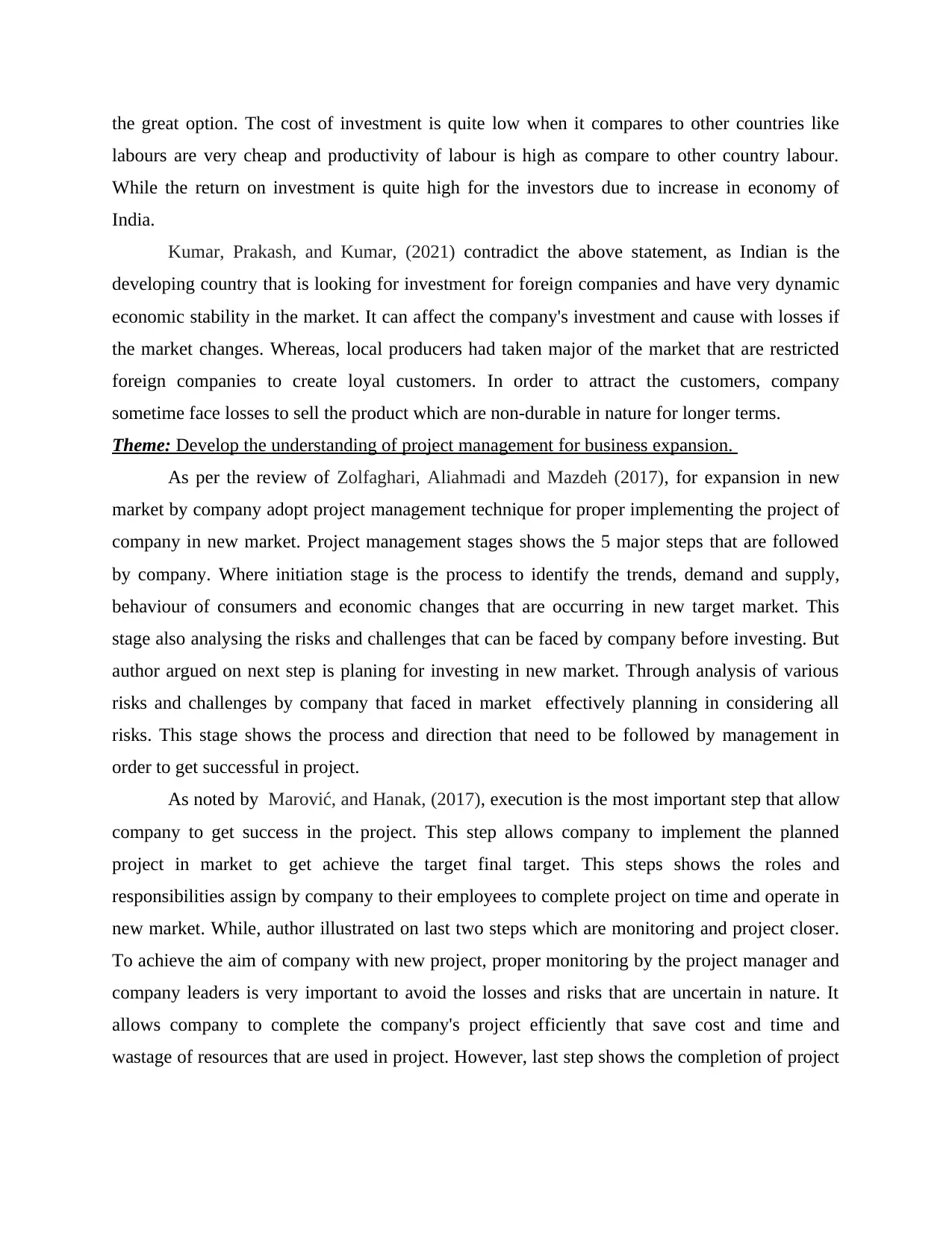
the great option. The cost of investment is quite low when it compares to other countries like
labours are very cheap and productivity of labour is high as compare to other country labour.
While the return on investment is quite high for the investors due to increase in economy of
India.
Kumar, Prakash, and Kumar, (2021) contradict the above statement, as Indian is the
developing country that is looking for investment for foreign companies and have very dynamic
economic stability in the market. It can affect the company's investment and cause with losses if
the market changes. Whereas, local producers had taken major of the market that are restricted
foreign companies to create loyal customers. In order to attract the customers, company
sometime face losses to sell the product which are non-durable in nature for longer terms.
Theme: Develop the understanding of project management for business expansion.
As per the review of Zolfaghari, Aliahmadi and Mazdeh (2017), for expansion in new
market by company adopt project management technique for proper implementing the project of
company in new market. Project management stages shows the 5 major steps that are followed
by company. Where initiation stage is the process to identify the trends, demand and supply,
behaviour of consumers and economic changes that are occurring in new target market. This
stage also analysing the risks and challenges that can be faced by company before investing. But
author argued on next step is planing for investing in new market. Through analysis of various
risks and challenges by company that faced in market effectively planning in considering all
risks. This stage shows the process and direction that need to be followed by management in
order to get successful in project.
As noted by Marović, and Hanak, (2017), execution is the most important step that allow
company to get success in the project. This step allows company to implement the planned
project in market to get achieve the target final target. This steps shows the roles and
responsibilities assign by company to their employees to complete project on time and operate in
new market. While, author illustrated on last two steps which are monitoring and project closer.
To achieve the aim of company with new project, proper monitoring by the project manager and
company leaders is very important to avoid the losses and risks that are uncertain in nature. It
allows company to complete the company's project efficiently that save cost and time and
wastage of resources that are used in project. However, last step shows the completion of project
labours are very cheap and productivity of labour is high as compare to other country labour.
While the return on investment is quite high for the investors due to increase in economy of
India.
Kumar, Prakash, and Kumar, (2021) contradict the above statement, as Indian is the
developing country that is looking for investment for foreign companies and have very dynamic
economic stability in the market. It can affect the company's investment and cause with losses if
the market changes. Whereas, local producers had taken major of the market that are restricted
foreign companies to create loyal customers. In order to attract the customers, company
sometime face losses to sell the product which are non-durable in nature for longer terms.
Theme: Develop the understanding of project management for business expansion.
As per the review of Zolfaghari, Aliahmadi and Mazdeh (2017), for expansion in new
market by company adopt project management technique for proper implementing the project of
company in new market. Project management stages shows the 5 major steps that are followed
by company. Where initiation stage is the process to identify the trends, demand and supply,
behaviour of consumers and economic changes that are occurring in new target market. This
stage also analysing the risks and challenges that can be faced by company before investing. But
author argued on next step is planing for investing in new market. Through analysis of various
risks and challenges by company that faced in market effectively planning in considering all
risks. This stage shows the process and direction that need to be followed by management in
order to get successful in project.
As noted by Marović, and Hanak, (2017), execution is the most important step that allow
company to get success in the project. This step allows company to implement the planned
project in market to get achieve the target final target. This steps shows the roles and
responsibilities assign by company to their employees to complete project on time and operate in
new market. While, author illustrated on last two steps which are monitoring and project closer.
To achieve the aim of company with new project, proper monitoring by the project manager and
company leaders is very important to avoid the losses and risks that are uncertain in nature. It
allows company to complete the company's project efficiently that save cost and time and
wastage of resources that are used in project. However, last step shows the completion of project
⊘ This is a preview!⊘
Do you want full access?
Subscribe today to unlock all pages.

Trusted by 1+ million students worldwide
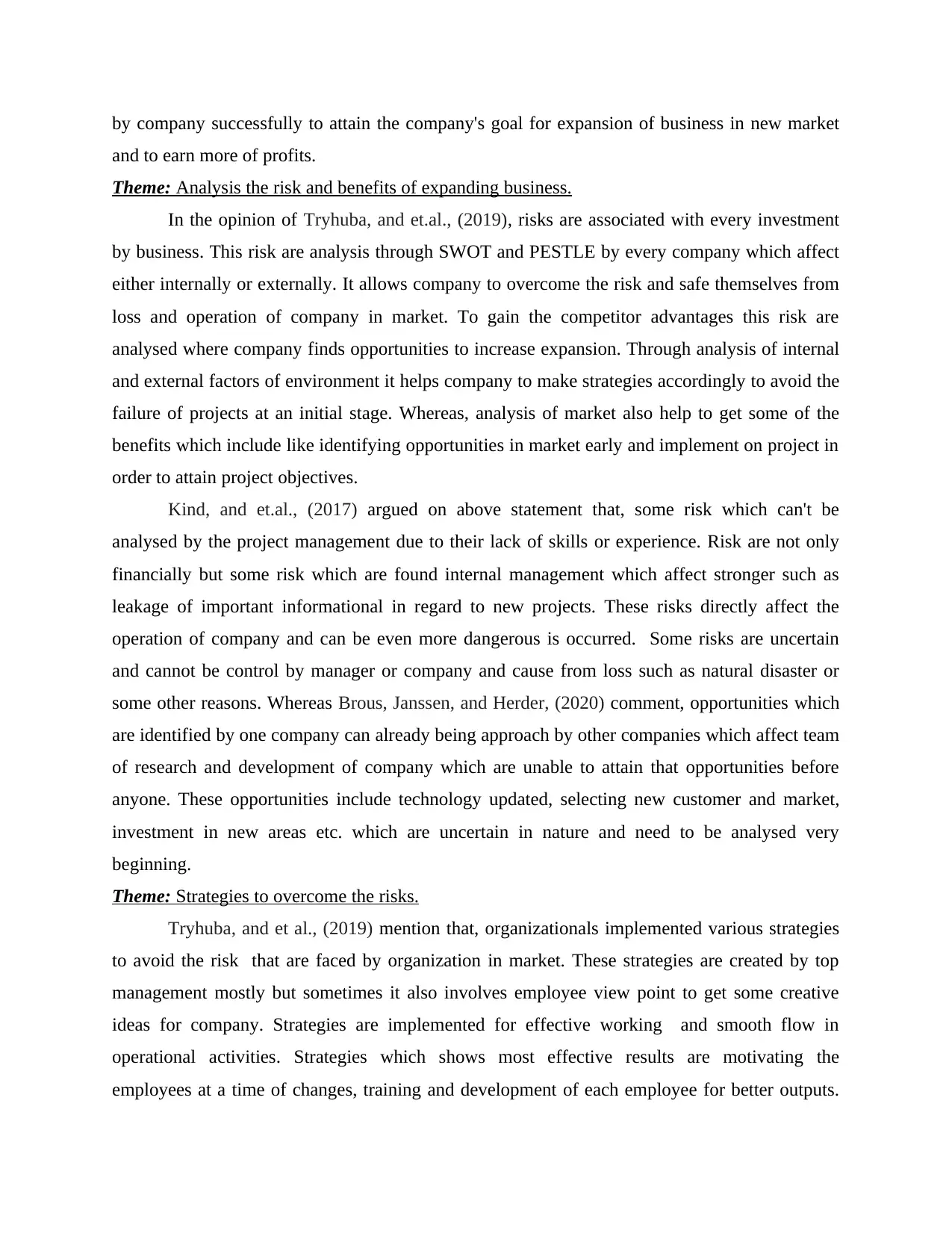
by company successfully to attain the company's goal for expansion of business in new market
and to earn more of profits.
Theme: Analysis the risk and benefits of expanding business.
In the opinion of Tryhuba, and et.al., (2019), risks are associated with every investment
by business. This risk are analysis through SWOT and PESTLE by every company which affect
either internally or externally. It allows company to overcome the risk and safe themselves from
loss and operation of company in market. To gain the competitor advantages this risk are
analysed where company finds opportunities to increase expansion. Through analysis of internal
and external factors of environment it helps company to make strategies accordingly to avoid the
failure of projects at an initial stage. Whereas, analysis of market also help to get some of the
benefits which include like identifying opportunities in market early and implement on project in
order to attain project objectives.
Kind, and et.al., (2017) argued on above statement that, some risk which can't be
analysed by the project management due to their lack of skills or experience. Risk are not only
financially but some risk which are found internal management which affect stronger such as
leakage of important informational in regard to new projects. These risks directly affect the
operation of company and can be even more dangerous is occurred. Some risks are uncertain
and cannot be control by manager or company and cause from loss such as natural disaster or
some other reasons. Whereas Brous, Janssen, and Herder, (2020) comment, opportunities which
are identified by one company can already being approach by other companies which affect team
of research and development of company which are unable to attain that opportunities before
anyone. These opportunities include technology updated, selecting new customer and market,
investment in new areas etc. which are uncertain in nature and need to be analysed very
beginning.
Theme: Strategies to overcome the risks.
Tryhuba, and et al., (2019) mention that, organizationals implemented various strategies
to avoid the risk that are faced by organization in market. These strategies are created by top
management mostly but sometimes it also involves employee view point to get some creative
ideas for company. Strategies are implemented for effective working and smooth flow in
operational activities. Strategies which shows most effective results are motivating the
employees at a time of changes, training and development of each employee for better outputs.
and to earn more of profits.
Theme: Analysis the risk and benefits of expanding business.
In the opinion of Tryhuba, and et.al., (2019), risks are associated with every investment
by business. This risk are analysis through SWOT and PESTLE by every company which affect
either internally or externally. It allows company to overcome the risk and safe themselves from
loss and operation of company in market. To gain the competitor advantages this risk are
analysed where company finds opportunities to increase expansion. Through analysis of internal
and external factors of environment it helps company to make strategies accordingly to avoid the
failure of projects at an initial stage. Whereas, analysis of market also help to get some of the
benefits which include like identifying opportunities in market early and implement on project in
order to attain project objectives.
Kind, and et.al., (2017) argued on above statement that, some risk which can't be
analysed by the project management due to their lack of skills or experience. Risk are not only
financially but some risk which are found internal management which affect stronger such as
leakage of important informational in regard to new projects. These risks directly affect the
operation of company and can be even more dangerous is occurred. Some risks are uncertain
and cannot be control by manager or company and cause from loss such as natural disaster or
some other reasons. Whereas Brous, Janssen, and Herder, (2020) comment, opportunities which
are identified by one company can already being approach by other companies which affect team
of research and development of company which are unable to attain that opportunities before
anyone. These opportunities include technology updated, selecting new customer and market,
investment in new areas etc. which are uncertain in nature and need to be analysed very
beginning.
Theme: Strategies to overcome the risks.
Tryhuba, and et al., (2019) mention that, organizationals implemented various strategies
to avoid the risk that are faced by organization in market. These strategies are created by top
management mostly but sometimes it also involves employee view point to get some creative
ideas for company. Strategies are implemented for effective working and smooth flow in
operational activities. Strategies which shows most effective results are motivating the
employees at a time of changes, training and development of each employee for better outputs.
Paraphrase This Document
Need a fresh take? Get an instant paraphrase of this document with our AI Paraphraser

However, retail sector is very dynamic and changes frequently that affect organization working
with cost and revenue generated, demand and supply of goods and quality of product that need to
be updated with time with the help of strategies. It allows companies to provide customer
satisfaction to attract the customers by effective offering. Strategies also include the service that
are provided by organization to their valuable customers and how these customers are being
promoted company's services in market.
But Demirkesen, and Ozorhon, (2017) criticize that, strategies are not fully implemented
as they are planned by the company due to lack of skills and knowledge of employees. It
ultimately affects the company objective to attain from the particular task. Some strategies like
training and development of employees are unable to provide due to high cost incurred and
pricing strategies are also fails sue to unmatch market structure price of products. Organization
finds difficult to overcome the risk sometime when it is effect the company's working. Changing
environment and taste of consumers are one of major risks which are faced by retail industries.
As consumers demand are frequently changes with the change in price and quality of goods and
market environment affect the operation of company. Research and development team of
organizations are unable to find the changes and operate in risk market sometimes.
PROJECT OBJECTIVES
Aim: To analyse the risk and benefits associated with project of business expansion in India: A
study in Aldi.
Objectives:
To identity the current trends in India for expansion.
To develop understanding related to various stages of project management with respect to
business expansion in India.
To analyse the risks and benefits in relation with expanding business in India. To identify the strategies to overcome the risks and benefits on expansion.
Rationale:
Reason implicit selection of current topic is to recognize the risk and benefits for
expanding business in India. The demand offering with low price with high quality product had
gained more attain in Asian market and new opportunities are available in market. India is one of
leading market and demand for products are accelerated and can gain competitive advantage
through new offerings. Hence, due to this reason Aldi is planning for expanding in Indian
with cost and revenue generated, demand and supply of goods and quality of product that need to
be updated with time with the help of strategies. It allows companies to provide customer
satisfaction to attract the customers by effective offering. Strategies also include the service that
are provided by organization to their valuable customers and how these customers are being
promoted company's services in market.
But Demirkesen, and Ozorhon, (2017) criticize that, strategies are not fully implemented
as they are planned by the company due to lack of skills and knowledge of employees. It
ultimately affects the company objective to attain from the particular task. Some strategies like
training and development of employees are unable to provide due to high cost incurred and
pricing strategies are also fails sue to unmatch market structure price of products. Organization
finds difficult to overcome the risk sometime when it is effect the company's working. Changing
environment and taste of consumers are one of major risks which are faced by retail industries.
As consumers demand are frequently changes with the change in price and quality of goods and
market environment affect the operation of company. Research and development team of
organizations are unable to find the changes and operate in risk market sometimes.
PROJECT OBJECTIVES
Aim: To analyse the risk and benefits associated with project of business expansion in India: A
study in Aldi.
Objectives:
To identity the current trends in India for expansion.
To develop understanding related to various stages of project management with respect to
business expansion in India.
To analyse the risks and benefits in relation with expanding business in India. To identify the strategies to overcome the risks and benefits on expansion.
Rationale:
Reason implicit selection of current topic is to recognize the risk and benefits for
expanding business in India. The demand offering with low price with high quality product had
gained more attain in Asian market and new opportunities are available in market. India is one of
leading market and demand for products are accelerated and can gain competitive advantage
through new offerings. Hence, due to this reason Aldi is planning for expanding in Indian
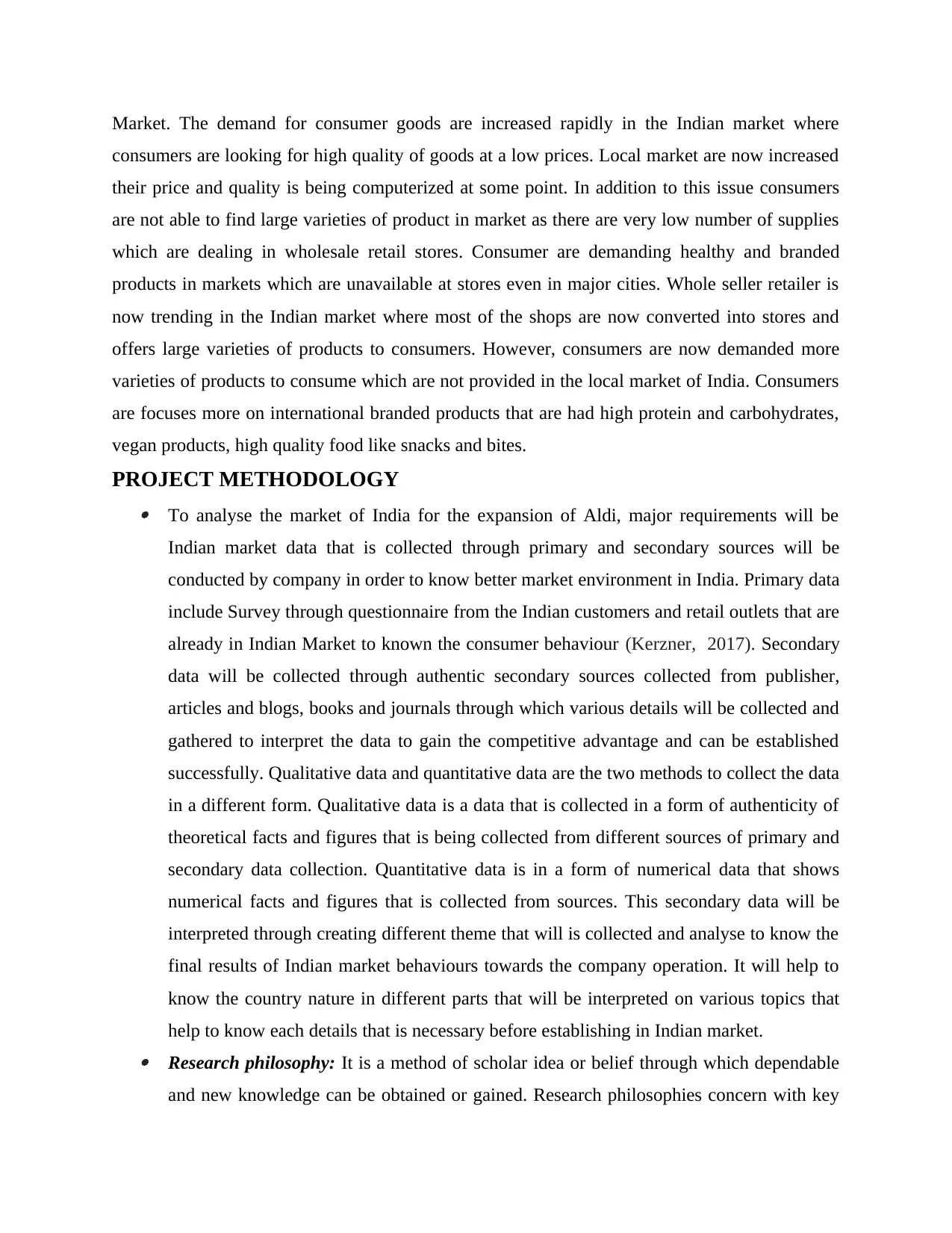
Market. The demand for consumer goods are increased rapidly in the Indian market where
consumers are looking for high quality of goods at a low prices. Local market are now increased
their price and quality is being computerized at some point. In addition to this issue consumers
are not able to find large varieties of product in market as there are very low number of supplies
which are dealing in wholesale retail stores. Consumer are demanding healthy and branded
products in markets which are unavailable at stores even in major cities. Whole seller retailer is
now trending in the Indian market where most of the shops are now converted into stores and
offers large varieties of products to consumers. However, consumers are now demanded more
varieties of products to consume which are not provided in the local market of India. Consumers
are focuses more on international branded products that are had high protein and carbohydrates,
vegan products, high quality food like snacks and bites.
PROJECT METHODOLOGY To analyse the market of India for the expansion of Aldi, major requirements will be
Indian market data that is collected through primary and secondary sources will be
conducted by company in order to know better market environment in India. Primary data
include Survey through questionnaire from the Indian customers and retail outlets that are
already in Indian Market to known the consumer behaviour (Kerzner, 2017). Secondary
data will be collected through authentic secondary sources collected from publisher,
articles and blogs, books and journals through which various details will be collected and
gathered to interpret the data to gain the competitive advantage and can be established
successfully. Qualitative data and quantitative data are the two methods to collect the data
in a different form. Qualitative data is a data that is collected in a form of authenticity of
theoretical facts and figures that is being collected from different sources of primary and
secondary data collection. Quantitative data is in a form of numerical data that shows
numerical facts and figures that is collected from sources. This secondary data will be
interpreted through creating different theme that will is collected and analyse to know the
final results of Indian market behaviours towards the company operation. It will help to
know the country nature in different parts that will be interpreted on various topics that
help to know each details that is necessary before establishing in Indian market. Research philosophy: It is a method of scholar idea or belief through which dependable
and new knowledge can be obtained or gained. Research philosophies concern with key
consumers are looking for high quality of goods at a low prices. Local market are now increased
their price and quality is being computerized at some point. In addition to this issue consumers
are not able to find large varieties of product in market as there are very low number of supplies
which are dealing in wholesale retail stores. Consumer are demanding healthy and branded
products in markets which are unavailable at stores even in major cities. Whole seller retailer is
now trending in the Indian market where most of the shops are now converted into stores and
offers large varieties of products to consumers. However, consumers are now demanded more
varieties of products to consume which are not provided in the local market of India. Consumers
are focuses more on international branded products that are had high protein and carbohydrates,
vegan products, high quality food like snacks and bites.
PROJECT METHODOLOGY To analyse the market of India for the expansion of Aldi, major requirements will be
Indian market data that is collected through primary and secondary sources will be
conducted by company in order to know better market environment in India. Primary data
include Survey through questionnaire from the Indian customers and retail outlets that are
already in Indian Market to known the consumer behaviour (Kerzner, 2017). Secondary
data will be collected through authentic secondary sources collected from publisher,
articles and blogs, books and journals through which various details will be collected and
gathered to interpret the data to gain the competitive advantage and can be established
successfully. Qualitative data and quantitative data are the two methods to collect the data
in a different form. Qualitative data is a data that is collected in a form of authenticity of
theoretical facts and figures that is being collected from different sources of primary and
secondary data collection. Quantitative data is in a form of numerical data that shows
numerical facts and figures that is collected from sources. This secondary data will be
interpreted through creating different theme that will is collected and analyse to know the
final results of Indian market behaviours towards the company operation. It will help to
know the country nature in different parts that will be interpreted on various topics that
help to know each details that is necessary before establishing in Indian market. Research philosophy: It is a method of scholar idea or belief through which dependable
and new knowledge can be obtained or gained. Research philosophies concern with key
⊘ This is a preview!⊘
Do you want full access?
Subscribe today to unlock all pages.

Trusted by 1+ million students worldwide

elements such as choice of research strategy, manner data will be gathered and analysed,
problem will be formulated and assessed (Ghadimi,, Toosi, and Heavey, 2018). For
current project plan, Mix methods approach uses for better understanding of Indian
market. Both qualitative and quantitative data will be used in project which respected to
use of interpretivism and positivist methods. Positivism and realism are two research
philosophies that are used by scholar while preparing project plan for research on Indian
market and crucial information can be gathered and understand for better expansion of
company (Madni, and Purohit, 2019). This philosophy is highly organized and
appropriate for collecting large samples and can be analysed through quantitative while
also be utilized in course of qualitative. However, realism philosophy is another approach
that will be used by scholar for pursuing respective process related to research topic of
study where it selects different methods according to objectives I.e. qualitative or
quantitative. This philosophy is mostly appropriate for quantitative study and emphasized
more on actual knowledge that comes from observation through measuring it. However,
it can be said that scholar has not taken into account of any human interest in research
study therefore, positivism philosophy is more effective for better completion of the
current study. Project sample: It is a technique which is used by scholar where few selected candidates
are selected from pollution which belongs to different categories. There are various
sample methods that are used by researcher to conduct the research on market to collect
the data from Indian Market for the better expansion of company and achieving the
objectives. Further, is can be understood that sampling methods is very cost effective and
according to time convenient to drive the information for the research (Nguyen, Cook,
and Ireland,2017). Sampling are of two types probability and non-probability sampling
used by scholar to conduct the research. First method shows that scholar set particular
selection method and member of population are also selected specifically on the basis of
indiscriminately to collect the relevant information. Therefore, this process allows all
members have equal opportunities to become a part of sample to collect reliable
information for research. Second method shows the Non probability method has neither
specify selection procedure nor set procedure, it is difficult to supply equal chance to all
selected population for sampling. For the primary researcher questionnaire will be made
problem will be formulated and assessed (Ghadimi,, Toosi, and Heavey, 2018). For
current project plan, Mix methods approach uses for better understanding of Indian
market. Both qualitative and quantitative data will be used in project which respected to
use of interpretivism and positivist methods. Positivism and realism are two research
philosophies that are used by scholar while preparing project plan for research on Indian
market and crucial information can be gathered and understand for better expansion of
company (Madni, and Purohit, 2019). This philosophy is highly organized and
appropriate for collecting large samples and can be analysed through quantitative while
also be utilized in course of qualitative. However, realism philosophy is another approach
that will be used by scholar for pursuing respective process related to research topic of
study where it selects different methods according to objectives I.e. qualitative or
quantitative. This philosophy is mostly appropriate for quantitative study and emphasized
more on actual knowledge that comes from observation through measuring it. However,
it can be said that scholar has not taken into account of any human interest in research
study therefore, positivism philosophy is more effective for better completion of the
current study. Project sample: It is a technique which is used by scholar where few selected candidates
are selected from pollution which belongs to different categories. There are various
sample methods that are used by researcher to conduct the research on market to collect
the data from Indian Market for the better expansion of company and achieving the
objectives. Further, is can be understood that sampling methods is very cost effective and
according to time convenient to drive the information for the research (Nguyen, Cook,
and Ireland,2017). Sampling are of two types probability and non-probability sampling
used by scholar to conduct the research. First method shows that scholar set particular
selection method and member of population are also selected specifically on the basis of
indiscriminately to collect the relevant information. Therefore, this process allows all
members have equal opportunities to become a part of sample to collect reliable
information for research. Second method shows the Non probability method has neither
specify selection procedure nor set procedure, it is difficult to supply equal chance to all
selected population for sampling. For the primary researcher questionnaire will be made
Paraphrase This Document
Need a fresh take? Get an instant paraphrase of this document with our AI Paraphraser
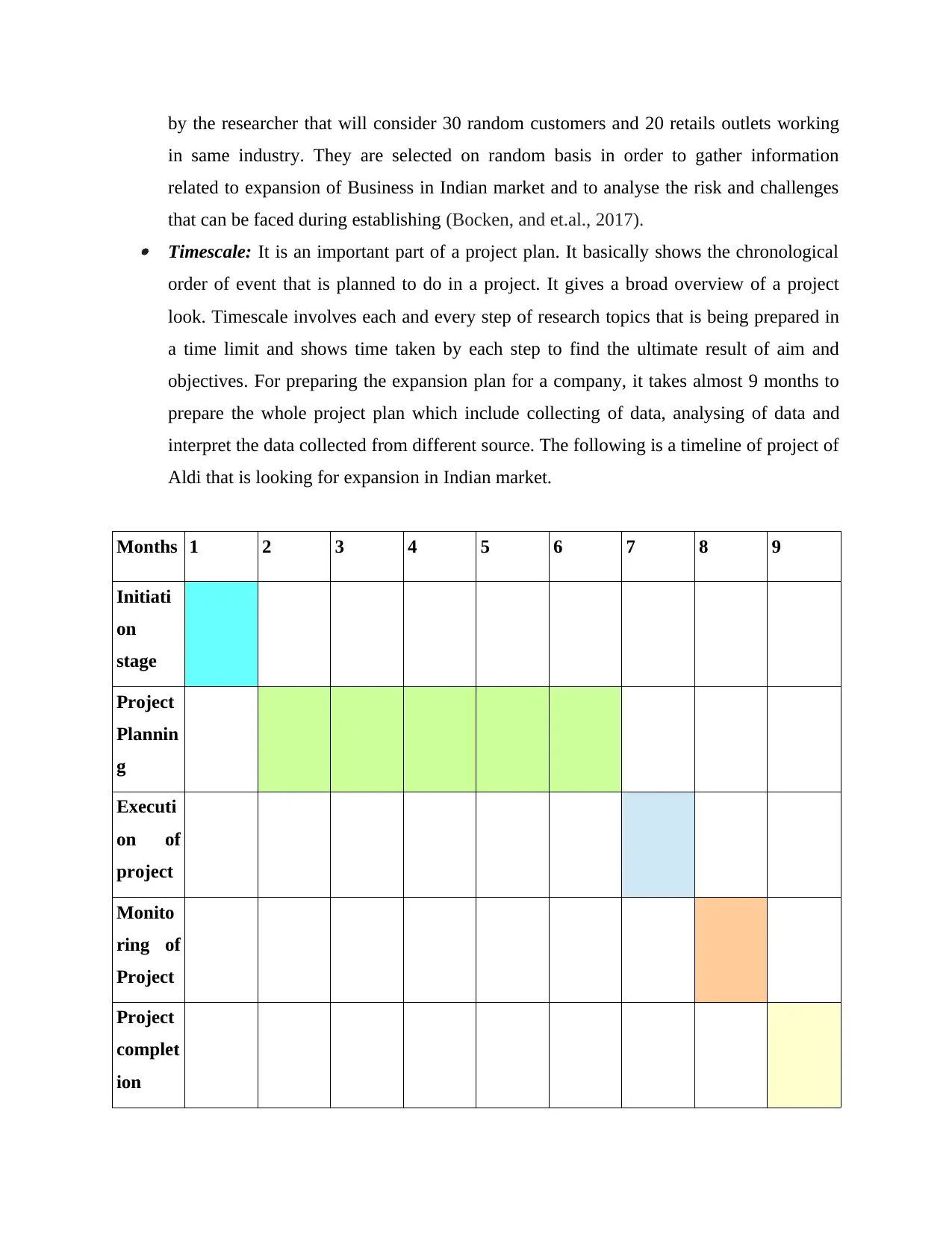
by the researcher that will consider 30 random customers and 20 retails outlets working
in same industry. They are selected on random basis in order to gather information
related to expansion of Business in Indian market and to analyse the risk and challenges
that can be faced during establishing (Bocken, and et.al., 2017). Timescale: It is an important part of a project plan. It basically shows the chronological
order of event that is planned to do in a project. It gives a broad overview of a project
look. Timescale involves each and every step of research topics that is being prepared in
a time limit and shows time taken by each step to find the ultimate result of aim and
objectives. For preparing the expansion plan for a company, it takes almost 9 months to
prepare the whole project plan which include collecting of data, analysing of data and
interpret the data collected from different source. The following is a timeline of project of
Aldi that is looking for expansion in Indian market.
Months 1 2 3 4 5 6 7 8 9
Initiati
on
stage
Project
Plannin
g
Executi
on of
project
Monito
ring of
Project
Project
complet
ion
in same industry. They are selected on random basis in order to gather information
related to expansion of Business in Indian market and to analyse the risk and challenges
that can be faced during establishing (Bocken, and et.al., 2017). Timescale: It is an important part of a project plan. It basically shows the chronological
order of event that is planned to do in a project. It gives a broad overview of a project
look. Timescale involves each and every step of research topics that is being prepared in
a time limit and shows time taken by each step to find the ultimate result of aim and
objectives. For preparing the expansion plan for a company, it takes almost 9 months to
prepare the whole project plan which include collecting of data, analysing of data and
interpret the data collected from different source. The following is a timeline of project of
Aldi that is looking for expansion in Indian market.
Months 1 2 3 4 5 6 7 8 9
Initiati
on
stage
Project
Plannin
g
Executi
on of
project
Monito
ring of
Project
Project
complet
ion
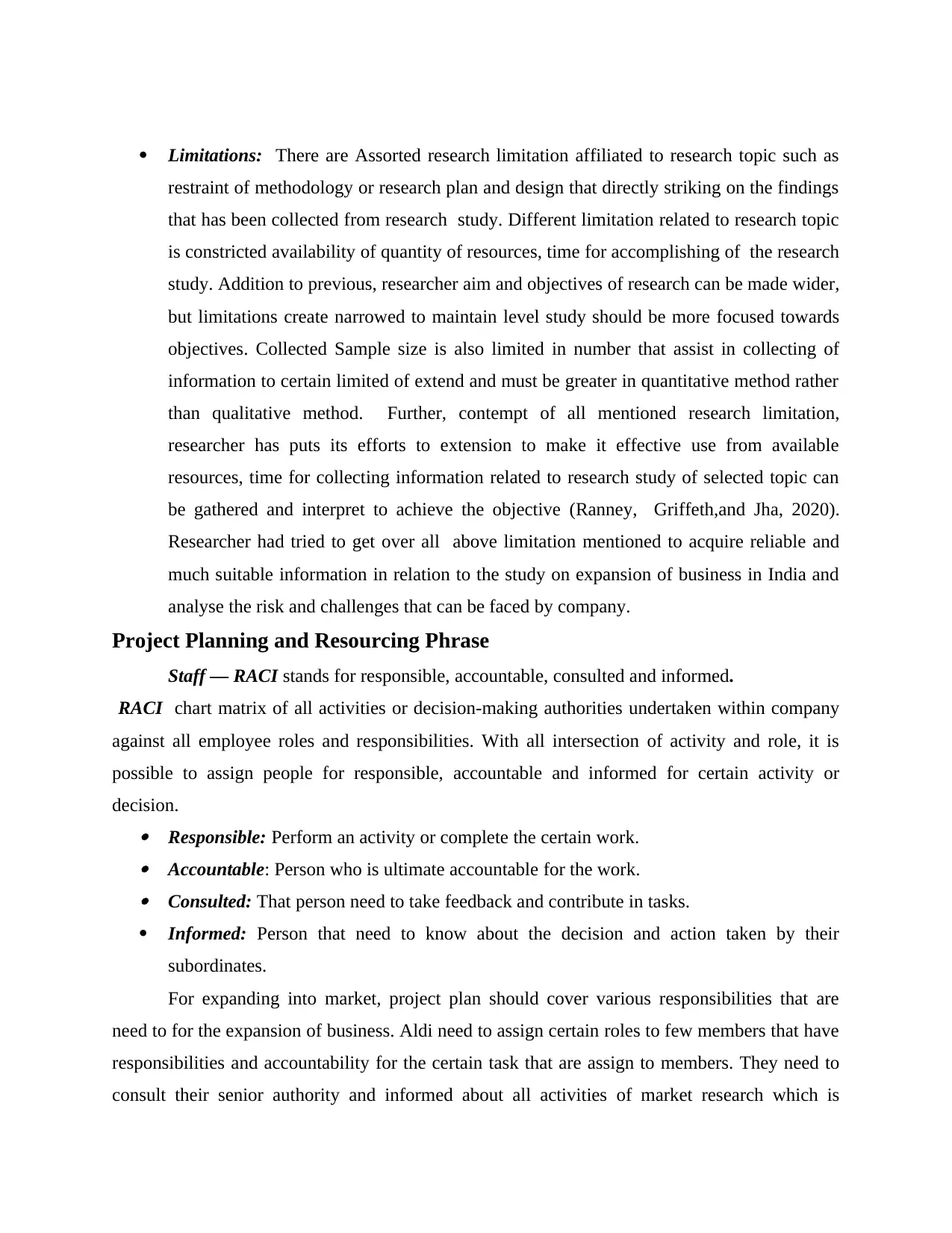
Limitations: There are Assorted research limitation affiliated to research topic such as
restraint of methodology or research plan and design that directly striking on the findings
that has been collected from research study. Different limitation related to research topic
is constricted availability of quantity of resources, time for accomplishing of the research
study. Addition to previous, researcher aim and objectives of research can be made wider,
but limitations create narrowed to maintain level study should be more focused towards
objectives. Collected Sample size is also limited in number that assist in collecting of
information to certain limited of extend and must be greater in quantitative method rather
than qualitative method. Further, contempt of all mentioned research limitation,
researcher has puts its efforts to extension to make it effective use from available
resources, time for collecting information related to research study of selected topic can
be gathered and interpret to achieve the objective (Ranney, Griffeth,and Jha, 2020).
Researcher had tried to get over all above limitation mentioned to acquire reliable and
much suitable information in relation to the study on expansion of business in India and
analyse the risk and challenges that can be faced by company.
Project Planning and Resourcing Phrase
Staff — RACI stands for responsible, accountable, consulted and informed.
RACI chart matrix of all activities or decision-making authorities undertaken within company
against all employee roles and responsibilities. With all intersection of activity and role, it is
possible to assign people for responsible, accountable and informed for certain activity or
decision. Responsible: Perform an activity or complete the certain work. Accountable: Person who is ultimate accountable for the work. Consulted: That person need to take feedback and contribute in tasks.
Informed: Person that need to know about the decision and action taken by their
subordinates.
For expanding into market, project plan should cover various responsibilities that are
need to for the expansion of business. Aldi need to assign certain roles to few members that have
responsibilities and accountability for the certain task that are assign to members. They need to
consult their senior authority and informed about all activities of market research which is
restraint of methodology or research plan and design that directly striking on the findings
that has been collected from research study. Different limitation related to research topic
is constricted availability of quantity of resources, time for accomplishing of the research
study. Addition to previous, researcher aim and objectives of research can be made wider,
but limitations create narrowed to maintain level study should be more focused towards
objectives. Collected Sample size is also limited in number that assist in collecting of
information to certain limited of extend and must be greater in quantitative method rather
than qualitative method. Further, contempt of all mentioned research limitation,
researcher has puts its efforts to extension to make it effective use from available
resources, time for collecting information related to research study of selected topic can
be gathered and interpret to achieve the objective (Ranney, Griffeth,and Jha, 2020).
Researcher had tried to get over all above limitation mentioned to acquire reliable and
much suitable information in relation to the study on expansion of business in India and
analyse the risk and challenges that can be faced by company.
Project Planning and Resourcing Phrase
Staff — RACI stands for responsible, accountable, consulted and informed.
RACI chart matrix of all activities or decision-making authorities undertaken within company
against all employee roles and responsibilities. With all intersection of activity and role, it is
possible to assign people for responsible, accountable and informed for certain activity or
decision. Responsible: Perform an activity or complete the certain work. Accountable: Person who is ultimate accountable for the work. Consulted: That person need to take feedback and contribute in tasks.
Informed: Person that need to know about the decision and action taken by their
subordinates.
For expanding into market, project plan should cover various responsibilities that are
need to for the expansion of business. Aldi need to assign certain roles to few members that have
responsibilities and accountability for the certain task that are assign to members. They need to
consult their senior authority and informed about all activities of market research which is
⊘ This is a preview!⊘
Do you want full access?
Subscribe today to unlock all pages.

Trusted by 1+ million students worldwide
1 out of 24
Related Documents
Your All-in-One AI-Powered Toolkit for Academic Success.
+13062052269
info@desklib.com
Available 24*7 on WhatsApp / Email
![[object Object]](/_next/static/media/star-bottom.7253800d.svg)
Unlock your academic potential
Copyright © 2020–2025 A2Z Services. All Rights Reserved. Developed and managed by ZUCOL.





